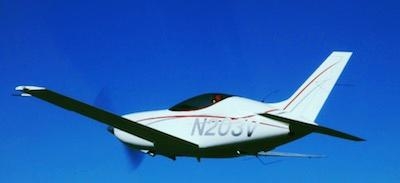You Can’t Keep A Good Airplane Down
By: Gene Yarbrough
The Questair Venture was an enigmatic and precocious little kit airplane in the late 80’s, ahead of its competitors and full of attitude and promise. Conceived and birthed in Greensboro, NC from highly experienced and knowledgeable engineers with cutting edge engineering and development tools, the Venture hoped to deliver high speed/high altitude near jet performance on a family sedan price tag of $50,000. Yet, company turmoil combined with persistent in-service difficulties, and a long and technically challenging build process doomed the flying egg.

The Venture, and fixed gear sister model Spirit, aimed to provide the owner the ability to fly at fairly high altitudes (approx. 30,000 feet) and very high speeds for a single engine airplane (about 300kts) at very fuel efficient burn rates and around 1000 miles range all on a normally aspirated Continental IO-550, a very ambitious undertaking indeed. The airplane was all metal riveted construction, with wet wings and retractable landing gear reminiscent of the F-16. This approach provide the builder with an airplane with well-known established structural properties, and well known maintenance and repair plans for a long life. However, due to stretch formed wing and fuselage skins, the kit required building skills few possess in the kit-builder world. Still, many kits were sold in the few short years the company was operated, but only a small fraction of the kits ever flew, and many kits are still laying around the country waiting to come into the right hands. Of the numbers that were successfully
built many succumbed to gremlins in the landing gear system and some to owner ineptness.
According to the company's new owners, the company never turned a profit and in fact lost around $10,000 per kit. Along with internal chaos and "pirate-like" business shenanigans, the promise of the Venture never truly materialized, and the company wasn’t around long enough to work through the design issues. Around 1991 the company changed hands and was sold (maybe stolen) from the founders and was relocated to the Chicago area. Subsequently the owner and Chief engineer were killed in an unfortunate and mysterious accident, apparently caused by an experimental engine installation gone wrong and poor piloting skills. The company changed hands again and was moved to San Diego, now in the hands of a previous Venture Kit builder, for the purposes of maintaining some semblance of parts and spares for the builder community. Unfortunately that owner did little more than hold the company in possession, and little of anything to progress the project. At some point in 2016/2017 the current owners, Dan
Myers and Jim Cook acquired the assets and moved everything to its new home in Raymond, MS. Jim and Dan have revived the Questair name and are now looking to bring the kit back to production and remedy some of the issues plaguing the bird.
Of the significant issues to be sorted are the braking and steering bugs that are at the root of the operational problems. The original design called for differential braking with no direct nose wheel steering and main landing gear struts that did not provide adequate lateral stability, allowing the airplane to lean to one side or the other. The Venture can be a handful during taxi operations and has caused several incidents due to poor ground directional control in certain speed envelopes between slow taxi and airspeeds sufficient to provide positive aerodynamic control. Several builders have developed direct nose wheel steering modifications ... with mixed success and snafus all their own. The landing gear strut problem seems to have been eliminated with a change to the air/oil ratio and a pressure adjustment. Technical problems aside, owner operational knowledge and education has caused more incidents than outright design bugs. Like any high performance machine, the Venture requires a knowledgeable
hand and proper respect. Being fully versed in the Venture’s quirks as owners and builders, Jim and Dan have a laser focus on the issues and fairly complete ideas on fixes and solutions.
Jim and Dan presented at Airventure 2017, announcing their plans for the new company, kits and a quick-build option. Currently the company is quartered in a hangar in Raymond, MS with all the original factory tooling and engineering data. The one and only Spirit is also in their possession, and is likely to be the real gem in the deal. As to availability and cost, the company can only speculate as they have not developed firm numbers. But they are diligently working towards manufacturing and sales operations.
Having been personally involved with building Ventures and the wings on the Spirit, I certainly would enjoy seeing this project coming back to market. Perhaps with the new Part 23 rewrite, this little covey can be more than they ever were.
 ANN FAQ: Contributing To Aero-TV
ANN FAQ: Contributing To Aero-TV Aero-News: Quote of the Day (12.10.25)
Aero-News: Quote of the Day (12.10.25) ANN's Daily Aero-Term (12.10.25): North Atlantic High Level Airspace (NAT HLA)
ANN's Daily Aero-Term (12.10.25): North Atlantic High Level Airspace (NAT HLA) Airborne 12.08.25: Samaritans Purse Hijack, FAA Med Relief, China Rocket Fail
Airborne 12.08.25: Samaritans Purse Hijack, FAA Med Relief, China Rocket Fail Airborne-Flight Training 12.04.25: Ldg Fee Danger, Av Mental Health, PC-7 MKX
Airborne-Flight Training 12.04.25: Ldg Fee Danger, Av Mental Health, PC-7 MKX



